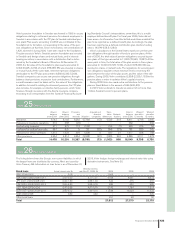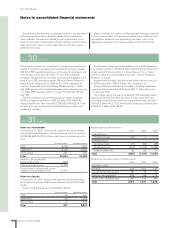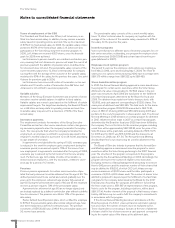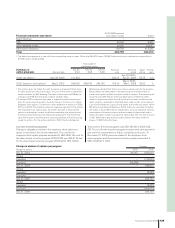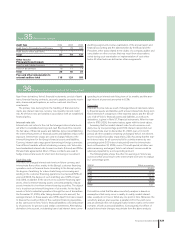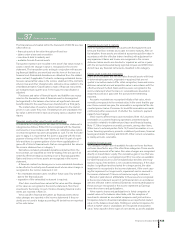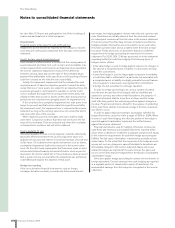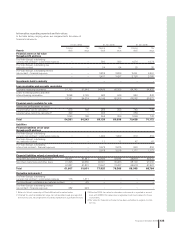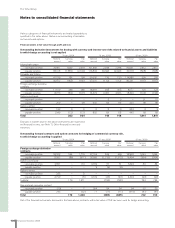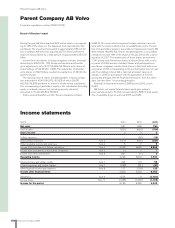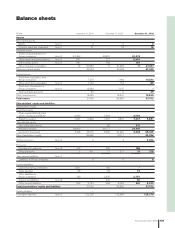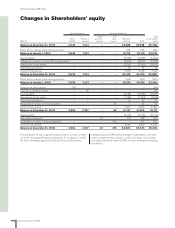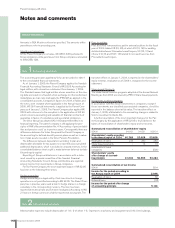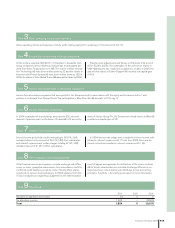Volvo 2006 Annual Report Download - page 137
Download and view the complete annual report
Please find page 137 of the 2006 Volvo annual report below. You can navigate through the pages in the report by either clicking on the pages listed below, or by using the keyword search tool below to find specific information within the annual report.
Financial information 2006 133
Note 37 Financial instruments
The fi n ancial assets treated within the framework of IAS 39 are clas-
sifi ed either as
• fi n ancial assets at fair value through profi t and loss
• claims under a loan and receivables
• investments held to maturity and
• available-for-sale fi n ancial assets
Transaction expenses are included in the asset’s fair value except in
cases in which the change in value is recognized in the income
statement. The transaction costs arising in conjunction with assum-
ing fi n ancial liabilities are amortized over the term of the loan as a
fi n a ncial cost. Embedded derivatives are detached from the related
main contract, if applicable. Contracts containing embedded deriva-
tives are valued at fair value in the income statement if the contracts
inherent risk and other characteristics indicate a close relation to the
embedded derivative. Classifi cations made of fi nancial instruments
are evaluated each quarter and, if necessary, the classifi cation is
adjusted.
Purchases and sales of fi nancial assets and liabilities are recog-
nized on the transaction date. A fi n ancial asset is derecognized
(extinguished) in the balance sheet when all signifi cant risks and
benefi ts linked to the asset have been transferred to a third party.
The market value of assets is determined based on the market
prices in such cases they exist. If market prices are unavailable, the
fair value is determined for each asset using various valuation tech-
niques.
Financial assets at fair value through profi t and loss
A fi n ancial asset recognized at fair value in the income statement is
categorized as follows: Either (1) it is recognized with the fi n ancial
instruments or in accordance with (2) the so-called fair value option
on initial recognition has been designated as such. For the fi r st cate-
gory to apply, it is required that the asset is acquired with the main
purpose of being sold in the near future and that it is part of a port-
folio and there is a proven pattern of short-term capitalization of
gains. All of Volvo’s fi n ancial assts that are recognized at fair value in
the income statement are in category 1.
Derivatives, included embedded derivatives detached from the
host contract, are classifi ed as held-for-trading if the are part of an
evidently effective hedge accounting or are a fi n ancial guarantee.
Gains and losses on these assets are recognized in the income
statement.
A fi n ancial contract containing one or more embedded derivatives
is classifi ed in its entirety as a fi n ancial asset whose value change is
recognized in the income statement if not:
• the embedded derivative does not affect future cash fl ow attribut-
able to the fi nancial asset.
• separation of the embedded instrument is required.
Short-term investments are valued at fair value and the changes
in this value are recognized in the income statement. Short-term
investments that mainly consist of interest-bearing fi n ancial instru-
ments are reported in Note 21.
Volvo classifi es fi nancial derivatives as fi nancial assets whose
value changes are reported in the income statements if they evi-
dently are not used in hedge accounting. All derivatives are reported
in this note below.
Financial assets held to maturity
Held-to-maturity investments are assets with fi xed payments and
term and that Volvo intends and is able to hold to maturity. After ini-
tial valuation, these assets are valued at accrued acquisition value in
accordance with the effective interest method, with adjustment for
any impairment. Gains and losses are recognized in the income
statement when assets are divested or impaired as well as in pace
with the accrued interested being reported. At year end 2006 Volvo
did not have any fi n ancial instruments classifi ed in this category.
Claims under a loan and receivables
Loans and receivables are non-derivative fi n ancial assets with fi xed
or determinable payments, originated or acquired, that are not
quoted in an active market. After initial recognition, loans and receiv-
ables are valued at accrued acquisition value in accordance with the
effective interest method. Gains and losses are recognized in the
income statement when the loans or receivables are divested or
impaired as well as in pace with the accrued interested being
reported.
Accounts receivable are recognized initially at fair value, which
normally corresponds to the nominal value. In the event that the pay-
ment terms exceed one year, the receivable is recognized at the dis-
counted present value. Provisions for doubtful receivables are made
continuously after assessment of whether the customer’s payment
capacity has changed.
Volvo reports different loans and receivables. Note 16, Long-term
receivables in customer fi nancing operations presented mainly
receivables related to installment purchases and fi n ancial leasing.
Note 17, Other long-term receivable, presents, among other items,
Other loans to external parties. Note 19, Current receivables in cus-
tomer fi nancing operations, presents installment purchases, fi n ancial
leasing and dealer fi nancing and Note 20, Other current receivables,
is mainly accounts receivable.
Available-for-sale assets
This category includes assets available for sales or those that have
not been classifi ed in any of the other three categories. These assets
are initially measured at fair value. Fair value changes are recognized
directly in shareholders’ equity. The cumulative gain or loss that was
recognized in equity is recognized in profi t or loss when an available-
for-sale fi nancial asset is sold. Unrealized value declines are recog-
nized in equity, if the decline is not considered temporary. If the value
decline is signifi cant and has lasted for a longer period, the value
impairment is recognized in the income statement. If the event caus-
ing the impairment no longer exists, impairment can be reversed in
the income statement if it does not involve an equity instrument.
Earned or paid interest attributable to these assets is recognized
in the income statement as part of net fi nancial items in accordance
with the effective interest method. Dividends received attributable to
these assts are recognized in the income statement as Earnings
from other shares and participations.
Volvo reports shares and participations in listed companies at
market value on the balance-sheet date, with the exception of
investments classed as associated companies and joint ventures.
Companies listed on fi nancial marketplaces are reported at market
value on the balance-sheet date. Holdings in unlisted companies for
which a market value is unavailable, are recognized at acquisition
value. Volvo classifi es these types of investments as assets available


